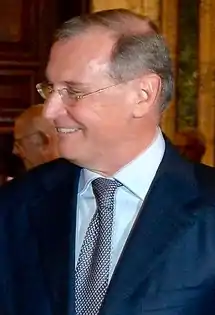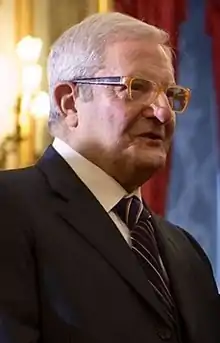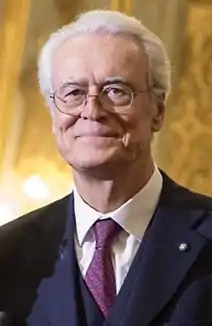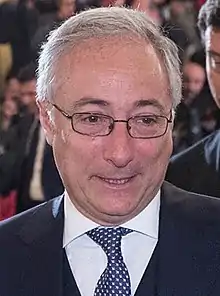Constitutional Court of Italy
The Constitutional Court of the Italian Republic (Italian: Corte costituzionale della Repubblica Italiana) is the highest court of Italy in matters of constitutional law. Sometimes, the name Consulta is used as a metonym for it, because its sessions are held in Palazzo della Consulta in Rome.
| Constitutional Court | |
|---|---|
  | |
| Established | 1948 (in the Constitution) 1955 (effective) |
| Jurisdiction | Italy |
| Location | Rome, Italy |
| Composition method | Elected/appointed in equal portions by Italian Parliament, President of the Italian Republic, and highest Italian courts |
| Authorized by | Constitution of Italy |
| Judge term length | 9 years (not renewable) |
| Number of positions | 15 |
| Website | Official website |
| President of the Court | |
| Currently | Silvana Sciarra |
| Since | 20 September 2022 |
| Part of the Politics series |
 |
|---|
|
|
History
The court is a post-World War II innovation, established by the republican Constitution of Italy in 1948, but it became operative only in 1955 after the enactment of the Constitutional Law n. 1 of 1953 and the Law n. 87 of 1953.[1] It held its first hearing in 1956.
Powers
According to Article 134[2] of the Italian Constitution, the Court shall pass judgement on:
- controversies on the constitutional legitimacy of laws issued by the State and Regions and when the Court declares a law unconstitutional, the law ceases to have effect the day after the publication of the ruling;
- conflicts arising from allocation of powers of the State and those powers allocated to State and Regions, and between Regions;
- charges brought against the President.
The constitutional court passes on the constitutionality of laws with no right of appeal.
Since 12 October 2007, when reform of the Italian intelligence agencies approved in August 2007 came into force, the pretext of state secret cannot be used to deny access to documents by the Court.
Composition
The Constitutional Court is composed of 15 judges for the term of service of nine years: 5 appointed by the President, 5 elected by the Parliament of Italy[3] and 5 elected by the ordinary and administrative supreme courts. Candidates need to be either lawyers with twenty years or more experience, full professors of law, or (former) judges of the Supreme Administrative, Civil and Criminal tribunals.[4] The members then elect the President of the Court. The President is elected from among its members in a secret ballot, by an absolute majority (8 votes in the case of a full court). If no person gets a majority, a runoff election between the two judges with the most votes occurs. The President of the Court appoints one or more vice-presidents to stand in for him in the event of his absence for any reason.
Current membership
- Appointed by
President of Italy Courts of Italy Parliament of Italy
| Portrait | Name | Profession | Appointed by | Appointed on | Date sworn in | End of term | Type of membership |
|---|---|---|---|---|---|---|---|
_(cropped).jpg.webp) | Silvana Sciarra (1948– ) | University professor | Parliament (17th Legislature) | 6 November 2014 | 11 November 2014 | 11 November 2023 | President (since 20 September 2022) |
 | Daria de Pretis (1956– ) | University professor | President (Giorgio Napolitano) | 18 October 2014 | 11 November 2014 | 11 November 2023 | Vice president (since 29 January 2022) |
 | Nicolò Zanon (1961– ) | University professor, lawyer | President (Giorgio Napolitano) | 18 October 2014 | 11 November 2014 | 11 November 2023 | Vice president (since 29 January 2022) |
 | Franco Modugno (1938– ) | University professor | Parliament (17th Legislature) | 16 December 2015 | 21 December 2015 | 21 December 2024 | Judge |
 | Augusto Barbera (1938– ) | University professor | Parliament (17th Legislature) | 16 December 2015 | 21 December 2015 | 21 December 2024 | Judge |
 | Giulio Prosperetti (1946– ) | University professor, lawyer | Parliament (17th Legislature) | 16 December 2015 | 21 December 2015 | 21 December 2024 | Judge |
 | Giovanni Amoroso (1949– ) | Magistrate | Courts (Court of Cassation) | 26 October 2017 | 13 November 2017 | 13 November 2026 | Judge |
 | Francesco Viganò (1966– ) | University professor, lawyer | President (Sergio Mattarella) | 24 February 2018 | 8 March 2018 | 8 March 2027 | Judge |
.jpg.webp) | Luca Antonini (1963– ) | University professor, lawyer | Parliament (18th Legislature) | 19 July 2018 | 26 July 2018 | 26 July 2027 | Judge |
 | Stefano Petitti (1953–) | Magistrate | Courts (Court of Cassation) | 28 November 2019 | 10 December 2019 | 10 December 2028 | Judge |
.jpg.webp) | Angelo Buscema (1952– ) | Magistrate | Courts (Court of Audit) | 12 July 2020 | 15 September 2020 | 15 September 2029 | Judge |
 | Emanuela Navarretta (1966– ) | University professor | President (Sergio Mattarella) | 9 September 2020 | 15 September 2020 | 15 September 2029 | Judge |
 | Maria Rosaria San Giorgio (1952– ) | Magistrate | Courts (Court of Cassation) | 16 December 2020 | 17 December 2020 | 17 December 2029 | Judge |
 | Filippo Patroni Griffi (1955– ) | Magistrate | Courts (Council of State) | 15 December 2021 | 29 January 2022 | 29 January 2031 | Judge |
.jpg.webp) | Marco D'Alberti (1948– ) | University professor | President (Sergio Mattarella) | 15 September 2022 | 20 September 2022 | 20 September 2031 | Judge |
References
- Italian Government, NORME SULLA COSTITUZIONE E SUL FUNZIONAMENTO DELLA CORTE COSTITUZIONALE, published 14 March 1953, accessed 5 October 2023
- "The Italian Constitution". The official website of the Presidency of the Italian Republic.
- Parliament appoints judges with increasing delay: see (in Italian)Giuseppe Salvaggiulo, Consulta, sfregio infinito. Ventisei votazioni fallite, in La Stampa, 3 October 2015 and (in Italian)Giampiero Buonomo, Negoziazione politica e Parlamento...Non solo risate, in Avanti online, 26 August 2015.
- Justin O. Frosini and Sara Pennicino (2 February 2007). "Report from Italy". thecourt.ca. Archived from the original on 30 January 2015. Retrieved 29 January 2015.